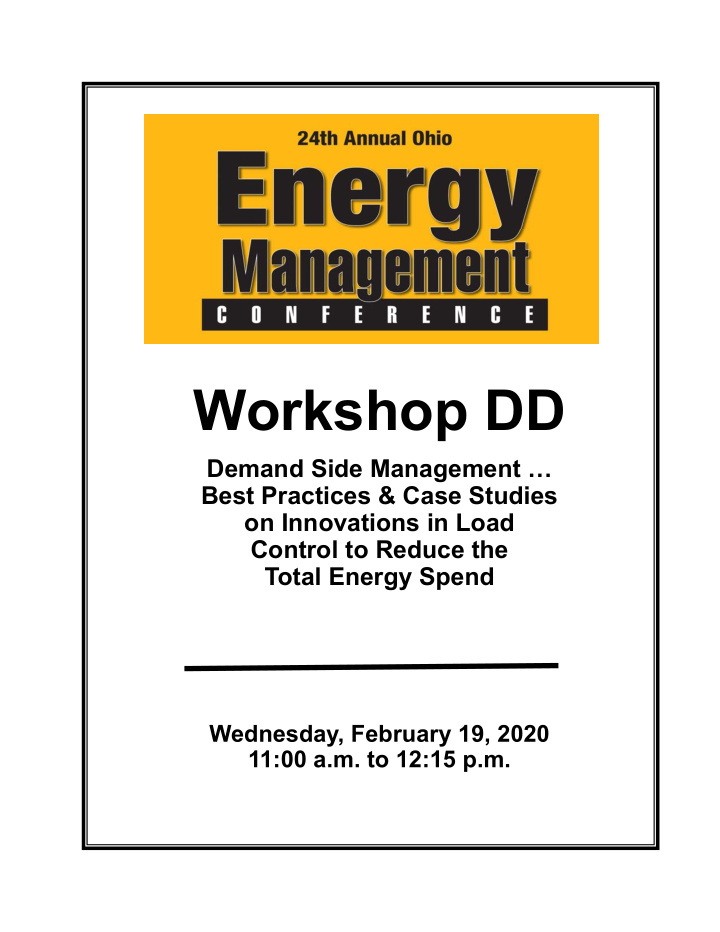



Workshop DD Demand Side Management … Best Practices & Case Studies on Innovations in Load Control to Reduce the Total Energy Spend Wednesday, February 19, 2020 11:00 a.m. to 12:15 p.m.
Biographical Information Donovan Dawson Senior Solutions Technical Advisor ENGIE Resources 1990 Post Oak Blvd, Suite 1900 Houston, TX 77056 donovan.dawson@engie.com Donovan is a Senior Solutions Technical Advisor at ENGIE Resources and is well versed in developing customer-centric plans that bring visibility, control, flexibility, and optimization to energy strategies. He’s an expert in demand management, creating economic value through innovative programs that shape pricing positions, monetize assets, and deliver greater value to customers through improved energy performance. Donovan’s background in the industry is extensive. He has sold commercial solar in Texas, worked in the commercial and industrial demand response division of EnerNOC, and developed smart building infrastructure projects for Johnson Controls and Honeywell. He earned a Bachelor of Arts in economics from The University of Texas at Austin.
DEMAND SIDE MANAGEMENT Best practices to improve load shape and lower total energy spend Donovan Dawson Senior Solutions Advisor DSM/DR ENGIE, Houston TX
ENGIE is Shaping a Sustainable Future 2
ENGIE’s Capabilities At-A-Glance 3
A SHOW OF HANDS Gaining Insight 1. Who currently participates in demand response? 2. How many work in procurement? 3. How many work in energy management/operations? 4. How many would categorize themselves as “other”? 4
Today’s Agenda: Connecting the Dots Demand Side Management: The Toolkit Demand Response: Version 1.0 vs. Version 2.0 The Domino Effect 5
Demand Side Management: The Toolkit 6
Demand Response: Version 1.0 • Incentive programs – ISO /RTO/Utility – to lower energy consumption during grid stress, imbalance, or extreme pricing activity • Introduced out of necessity into DR industry • Three types of programs: capacity, economic, and regulation/ancillary • One-way conversation – “Turn Stuff Off” It was lack luster… fuzzy value proposition, program complexity, inconsistency across markets 7
Demand Response: Version 2.0 • Load flexibility • Fast, responsive resources • Shimmy/shed/shift/shape • Demand response central hub to DERs • Microgrids – resilience and redundancy • Two-way conversation between distributed generation and dynamic loads • Grid services for non-wire solutions • Market-to-machine, facilitated by the internet of things, artificial intelligence, automated demand response Now we’re going somewhere… 8
The Domino Effect: Load Shape Influences Load Factor • Load shaping methods with DSM • Load factor (kWh usage/KW peak demand) and influence on total energy costs • Demand-side practices that lower long-term commodity costs • Solving for “systemic” solutions in the operation 9
The Domino Effect: Load Factor Influences Commodity Pricing Positions • Energy procurement practices • Black box bidding • Purchasing risk premium • Consumption uncertainty • Shorter terms 10
ENGIE’s Price Shaping Strategies WHAT are Price Shaping Strategies? • Custom economic programs that leverage data, energy efficiency measures, and demand response to optimize commodity procurement . • Tailored to achieve a better load shape for a better load factor specific to operational requirements and revenue objectives. WHO can benefit? Customers with: • A high need for resiliency, such as hospitals and data centers • Limited flexibility in when and how much energy is used during the day • Heavy cooling or heating processes • Low load factors (high intermittent usage with periods of low usage) WHY consider Price Shaping Strategies? • Minimize swings in usage • Bring predictability to load profiles for a more attractive commodity price position • Lower demand-related charges 11
Case Study: Demand Response Improves Resiliency ENGIE was initially invited to survey the site for demand response, yet we discovered issues with local power outages and no backup systems. ENGIE’s strategy: • Explore demand response programs • Lower demand charges • Improve power quality (surges/sags) at the wire mill (phase 1) • Provide proven technology that can react within sub-second response • Offer solutions with the ability to “ride-through” grid-wide power outages (~4 hours) • Monetize assets through demand response 12
Connecting the Dots for the Full Picture With an appropriate site assessment, the demand side management toolkit can be leveraged in a unique solution that lowers total energy spend by: • Mitigating peak demand charges • Identifying systemic operational issues • Realizing new revenue from demand response 2.0 • Improving load shape and load factors • Improving commodity pricing positions • Eliminating the need for premium supply risk adders 13
Contact Donovan Dawson Solution Sales Senior Advisor ENGIE North America O: (713) 636-1391 M: (713) 557-6244 donovan.dawson@engie.com 14
Recommend
More recommend